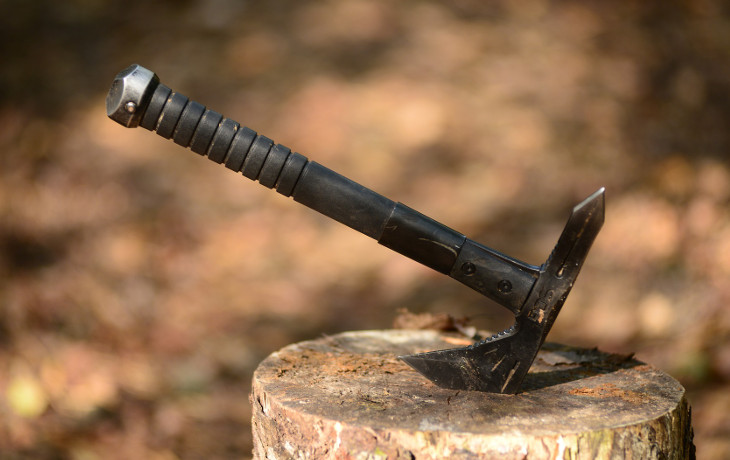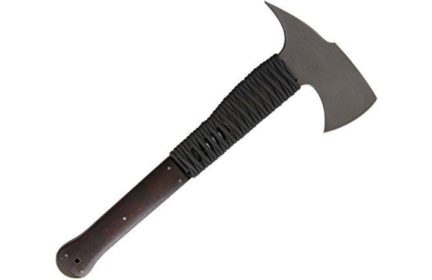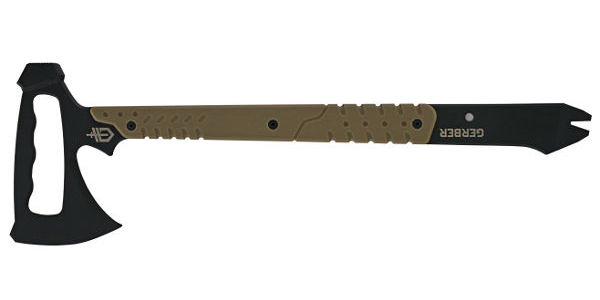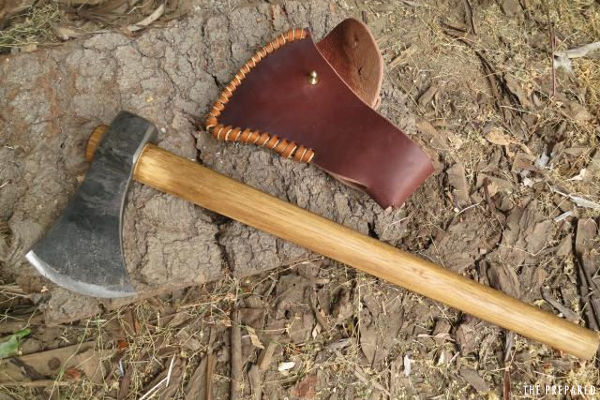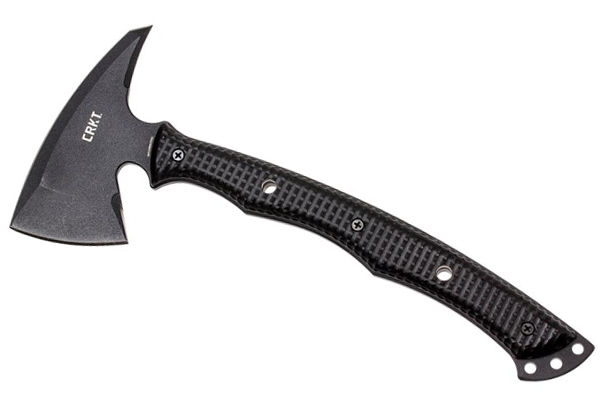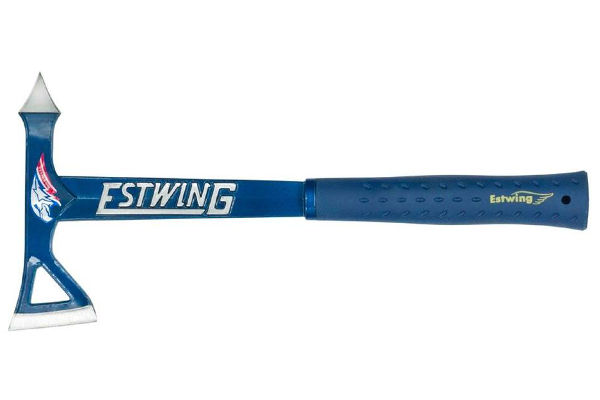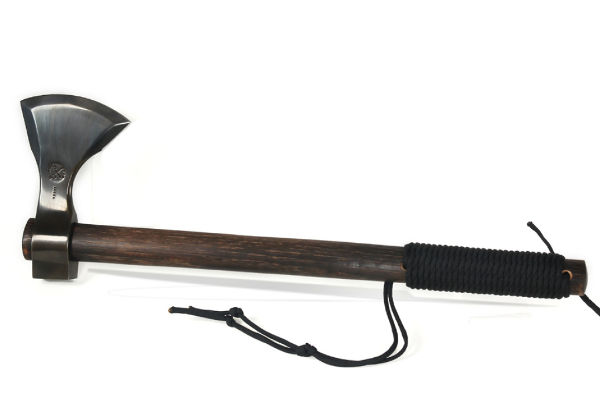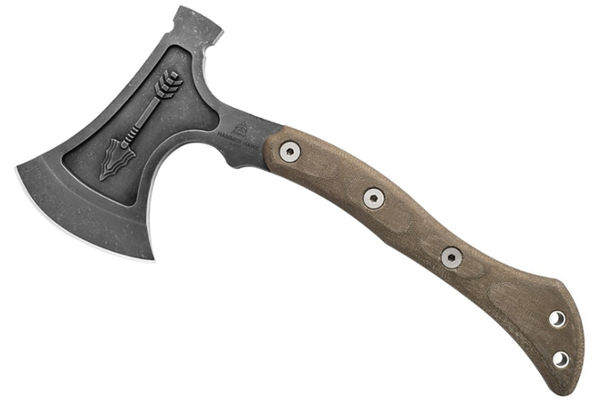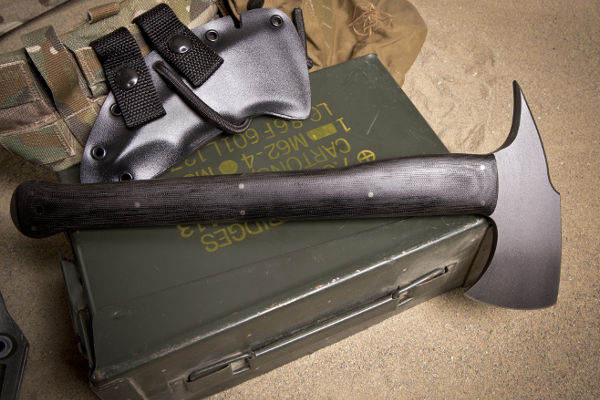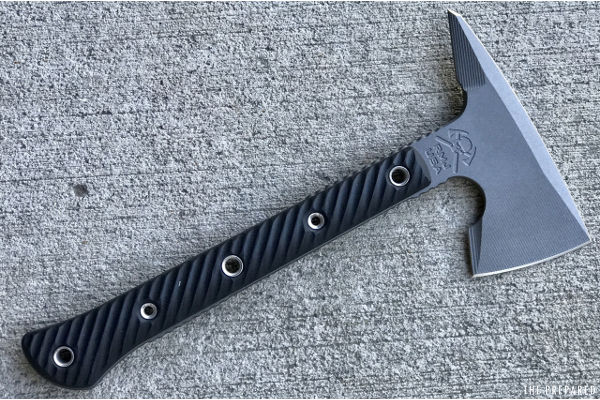The tactical tomahawk is a sibling of the hatchet, but where the hatchet is designed primarily for creative tasks like making firewood and shelter, the hawk’s primary mission is destruction. Sure, you can absolutely press a combat tomahawk into service for many of the same wilderness camp chores that a hatchet is naturally suited for — but this personal edged tool is optimized for three primary close-quarters functions: fighting, breaching, and (in many cases) throwing.
Because the modern, post-Vietnam tactical tomahawk is a tool for tearing things apart or making holes in everything from buildings to people, it’s usually owned by preppers whose vision of a major catastrophe involves conflict and breaking into locked buildings and containers. That’s why the combat tomahawk has seen a resurgence in recent years, particularly among elite soldiers in environments as diverse as the jungles of Southeast Asia to the deserts of the Middle East.
Preppers thinking more about wilderness and general-purpose survival tend to carry a well-reviewed hatchet instead. Even urban preppers, who care more about demolition tasks (like breaking into buildings), tend to favor a smaller fireman’s axe.
More: Not sure about the different types of bladed tools and which ones are best for your preps?
Full review notes and the spreadsheet of contenders is below the fold.
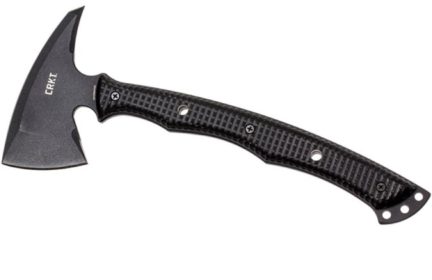
Best tactical tomahawk:
CRKT Kangee
The best tactical tomahawk for most people is the $191 CRKT Kangee, designed by uber-hawk maker RMJ Tactical and aimed at the entry-level tier of the tactical market. The SK5 steel is tough, while the ergonomics and features are first-rate. In addition to the main cutting edge, the Kangee has additional sharpened edges along the top of the head and bottom of the beard, giving it extra deep penetration.
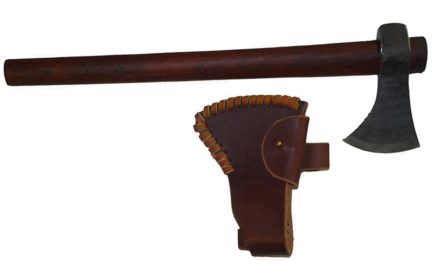
Best traditional tomahawk:
H&B Forge Small Camp Hawk
The $100 H&B Forge Small Camp Hawk is the best traditional wood-handled tomahawk for most people. There are very few wood-handled hawks in the sub-$100 price range that are both high-quality and not specifically optimized for throwing, which makes this hand-forged, USA-made hawk a standout. Also comes in medium and large variants, which feature longer handle sizes and slightly larger head sizes.
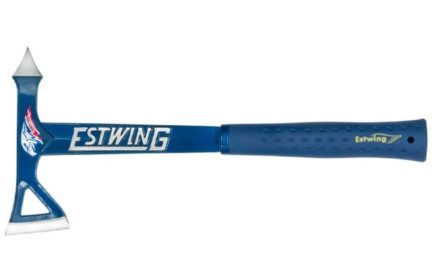
Budget Pick
Estwing Tomahawk
The $42 Estwing Tomahawk is a budget tomahawk that works as a fantastic “beater” blade for chopping and demolition work. This hawk is on the heavy side, but it’ll do most of what you need a hawk to do without breaking the bank.
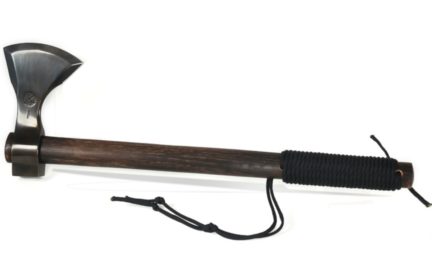
Upgrade Picks
2Hawks Warbeast
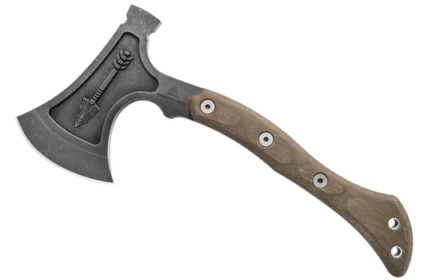
Upgrade Picks
TOPS Hammer Hawk
There’s a very meaningful jump in quality when you move into the over-$200 segment of the tomahawk market. The $275 2Hawks Warbeast, a premium, combination weapon and cutting tool that’s the best wood-handled hawk on the market, cranks the fit and finish all the way up to eleven. Like the Kangee, the Warbeast is sharpened along the top and bottom of the blade for maximum penetration, and we’d feel confident using this ultra-tough hawk for everything from cutting firewood to urban demolition.
The $315 TOPS Hammer Hawk is the best upgraded tactical tomahawk for most people. We feel the TOPS is actually worth the 200% price premium over the Kangee because of the guaranteed reliability and performance.
Also Great
Winkler Combat Axe
Top-end hawks, like the $600 Winkler Combat Axe or the $500 RMJ Jenny Wren, are on a whole different level than the other hawks in this review. These advanced tools have been fine-tuned over decades of use at the highest levels of the world’s militaries, and every subtle detail is the result of continuous feedback from operators who are using these tools in the field from Afghanistan to Africa. There is zero speculation or fantasy baked into these designs — they’re pure performance.
Be prepared. Don’t be a victim.
Want more great content and giveaways? Sign up for The Prepared’s free newsletter and get the best prepping content straight to your inbox. 1-2 emails a month, 0% spam.
Our tomahawk review criteria
A quick search will reveal an internet overflowing with tomahawks and other tactical Frankenstein tools. Based on personal experience, research, and interviews with other bushcrafters and soldiers, we’ve narrowed down the list to the top 23 contenders, below.
There’s a lot of crossover between tactical tomahawks as breaching tools and more specialized fire and rescue tools like the crash axe, but none of those are in the guide.
Our criteria to be included in this review:
- Not optimized for throwing, because unless you have a ton of practice and a backup weapon, throwing blades at threats is silly
- Not overly specialized for firefighting, demolition, or search and rescue
- A weapon and breaching tool first, with standard hatchet tasks like wood processing, carving, and game/food preparation a close enough second to still make sense as a hatchet alternative.
- High quality, based on reviews, first-hand experience, and company reputation
To give a concrete example of how we think about what’s appropriate for this guide, consider the Gerber Downrange Tomahawk. This tool has “tomahawk” in the name, and the size and shape are more or less in line with the other tomahawks we’ve listed. But the Downrange has one major feature that takes it out of the running for this guide: a giant hole in the chopping head.
The Downrange’s head hole, which is common in many crash axes, makes it easier to use for prying (see the crowbar head on the end of the handle). But all the weight removed from the head to create that handle drastically reduces the tool’s chopping ability, making the Downrange more of a crowbar with an axe head than an axe with a crowbar handle. Sure, it can still chop and hammer better than many tools, but the fact that it trades significant chopping ability for prying leverage makes this a specialized tool and not quite a “tomahawk” for the purposes of this guide.
The contenders
View the spreadsheet in Google Docs
Tomahawk basics
Basic tomahawk parts and names are in the best survival axe review.
Tomahawks come in two main flavors: classic tomahawks of the type trappers and frontiersmen used, and modern “tactical” hawks carried by soldiers and military contractors.
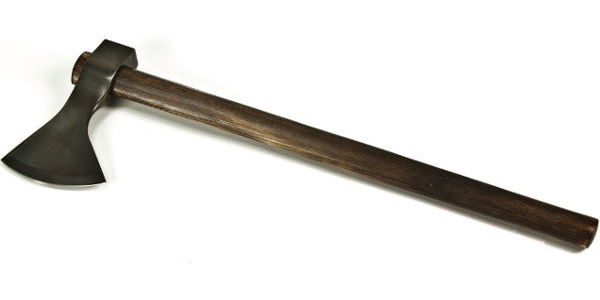
The classic, wood-handled tomahawk is a hand-to-hand and thrown weapon that can also be used for wood processing chores and other camp work. The hawk’s head shape is narrower than a hatchet’s, with a smaller blade that penetrates more deeply when thrown or swung. These features make it a very effective, controllable wood cutting tool — it can also be used to split wood, but it’s not ideal for that task.
The classic hawk typically comes with either a hammer poll or a rounded poll, with hammer polls being the most useful and the only kind we recommend.
Wooden handles on axe-style tools will eventually break. Replacing the handle in a total SHTF scenario is easier on a tomahawk because of the design:
- Tomahawk handles are straight, rather than the curved handles on hatchets and axes
- Tomahawk handles are round, others are oval
- Tomahawk handles are very slightly tapered, with the metal head attaching to the wider end and the hands holding the narrower end
- Tomahawk eyes (the hole that joins the handle to the wedge) are round, others are oval
- Tomahawk heads are joined to the handle with a simple friction fit (as opposed to hatchet heads, which need a wooden or metal edge driven into the top of the eye to expand them and lock them onto the handle)
It’s easier to create a straight and round handle with simple tools in the field than a curvy oval shape.
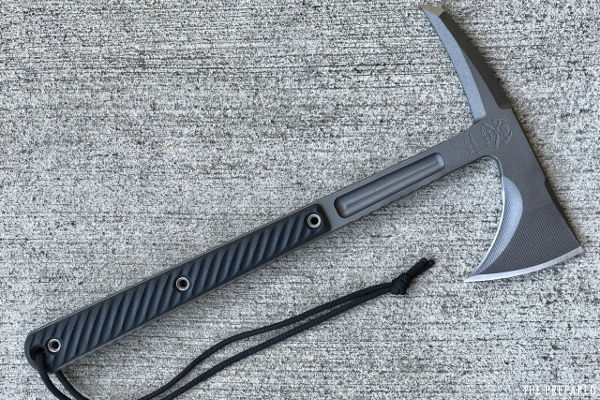
The modern tactical tomahawk is either machined from a single piece of steel, or it features a synthetic handle that’s bonded to the head. The all-steel one-piece hawks are practically indestructible, and can be used as pry bars, but they’re heavy for their size.
The most important thing to know about all-steel hawks is that good ones are expensive. There is a lot more premium, heat-treated steel and handle material in a tomahawk than there is in a field knife, so to get into the sweet spot for this type of tool you really need to pay well above $200.
Tactical tomahawks come with either hammer or spike polls, though the spike poll is most common. The spike poll aids in breaching and demolition, and allows the tool to be used as a pry bar for forcing open doors and windows. We’ve also heard of soldiers using the spikes to make holes in metal drums so that they can be chained together and form a perimeter.
Our experts prefer the spike poll because, while it’s often easy enough to find something at hand that you can hammer with in a pinch, it’s often not possible to fashion a field-expedient spike for digging and demolition.
The major downside of the spike is that it can make the hawk more difficult to use for carving, depending on the particulars (i.e. if the underside of the spike is sharpened and if the blade has a beard).
Best classic tomahawk for most people: H&B Forge Small Camp Hawk
- Price: $$$
- Specs: 15” length, 2 lbs weight, hickory handle, 5160 steel head
- Pros: tough, good brand reputation, versatile, field-replaceable handle
- Cons: not great at splitting wood
Who should buy this: Preppers who are in the market for a high-quality, wood-handled tomahawk in the sub-$100 range don’t have many choices, and the $100 H&B Small Camp Hawk is the best of a very narrow field. So if the extreme portability, handle replaceability, and classic styling of the traditional tomahawk appeal to you, then this is your best bet.
Benefits: Unlike many other wood-handled tomahawks, the Camp Hawk is optimized for camp chores and not for throwing. You get all the standard benefits of a traditional hawk — field-replaceable handle, superior cutting power, combat-capable balance, low weight — in a premium package.
Downsides: There are no downsides specific to this model that aren’t also there for wood-handled hawks as a class. The main downside that preppers will care about is the hawk’s unsuitability for splitting wood. You can split with it, but it’s not ideal, and in many cases you’d be better off batoning with a field knife.
Product and brand reputation: H&B Forge is a long-time favorite of re-enactors, but their products aren’t for show — these are high-quality, legitimate, hard-use tools that are gaining in popularity in bushcraft circles. This particular hawk is well-regarded, like all of H&B’s work.
Best tactical tomahawk for most people: CRKT Kangee
- Price: $$$
- Specs: 13.7” length, 1.55 lbs weight, synthetic handle, three edges
- Pros: tough, good brand reputation, relatively inexpensive, great design, light
- Cons: there are some quality control questions around this Taiwanese-made model
Who should buy this: The $191 CRKT Kangee is for preppers who want a well-designed, compact tactical hawk that can do fighting, demolition, and light chopping duties, but don’t want to break the bank on one of the higher end hawks.
Benefits: The main advantage of the Kangee is its simple, flawless design, courtesy of Ryan Johnson of RMJ Tactical. This is the closest you can get to one of Johnson’s well-loved hawks in this price range.
The Kangee is sharpened underneath its beard and all the way along its top, with the top edge wrapping around the rear spike. This design gives this hawk excellent penetration and gives you more options in a close-quarters combat situation.
SK5 is a shock-resistant high-carbon steel that’s ideal for a chopping blade like this.
Downsides: It’s difficult to reliably produce a quality, all-steel tomahawk in the sub-$100 range. That’s because a big enough piece of good steel and tight enough manufacturing tolerances are expensive. Most people who buy the Kangee will get a great hawk for the money, but a few people will get a bad one. So the odds you end up with a Kangee lemon that you have to send back are north of zero.
Brand and product reputation: CRKT is a solid brand that we generally have no problems recommending. In the case of the Kangee, we have read scattered reports of edge chipping and other failures on this hawk, but they aren’t widespread. Plenty of users have this hawk and have thoroughly abused it with no problems.
The important thing for preppers who are considering this hawk is to take it out and whack some hard wood with it, to make sure the steel and heat treatment on your unit are up to snuff. If you beat on it a bit and it holds up well, then congratulations: you got the best value in tactical tomahawks out there right now. And if it doesn’t, send it back and try again, or plan to pay more and move upmarket.
Best budget tomahawk: Estwing Tomahawk
- Price: $$
- Specs: 16” length, 1.68 lbs weight, synthetic handle, three edges
- Pros: tough, good brand reputation, inexpensive
- Cons: heavy, lower edge retention
Who should buy this: The $42 Estwing Tomahawk is best for preppers who want a “beater” chopping and demolition tool that will take any amount of abuse without causing you to worry about ruining a high-dollar purchase.
Urban preppers can stash this under a bed or in a closet for use in navigating a building damaged by an earthquake or storm, and suburban or rural preppers can use it for yard and camp chores.
Benefits: The Estwing’s all-metal construction and ductile steel give it durability, especially for demolition duties.
Downsides: The ductile steel means that edge retention is lower than higher-end hawks. The all-steel construction adds weight, creating a poor weight-to-performance ratio.
Brand and product reputation: Estwing is an American-made outdoors and prepper staple brand, and their chopping tools and hammers are loved by construction workers, homeowners, and campers. This hawk is one of their more obscure products, but it’s very well-reviewed as an inexpensive workhorse chopper. We’re not aware of any quality problems, and the main complaint seems to be the relative softness of the steel.
Best classic tomahawk upgrade: 2Hawks Warbeast
- Price: $$$$
- Specs: 19” length, 1.5 lbs weight, field-replaceable hickory handle, three edges
- Pros: tough, legendary brand reputation, versatile
- Cons: expensive
Who should buy this: The $275 2Hawks Warbeast is a functional work of art. It’s perfect for preppers who have their hearts set on a traditional, wood-handled hawk with maximum versatility and reliability.
Benefits: The Warbeast’s 6150 steel is a premium, high-carbon knife steel that will stand up to any amount of abuse while keeping a keen edge. At only 1.5 lbs, this hawk will out-cut (but not out-split) most hatchets that weigh a pound more, thanks to its hand-ground edge and head-forward weight distribution.
The fact that there are three bevels on the blade helps it when used as a weapon, since you can cut with a forward thrust or an inward-pulling hooking motion. The three bevels also allow the hatchet to be buried deeper into materials, increasing its usefulness as a demolition tool.
The head can be used for light hammering, and the darkened hickory handle is lightweight and strong.
Downsides: The only problem with this heirloom-quality tomahawk is the steep price. It is almost certainly not over 2.5 times as good as the H&B Forge hawk, so you pay a huge premium for the added functionality, fit, and finish.
Brand and product reputation: The 2Hawks forge is the only truly high-end, boutique maker operating in this space that we’re aware of. Other dedicated tomahawk makers have shut down in the past decade, but 2Hawks is still at it on the strength of its reputation for unmatched quality. This particular hawk is well-loved, and is many people’s dream tomahawk.
Best tactical tomahawk upgrade: TOPS Hammer Hawk
- Price: $$$$
- Specs: 14.5” length, 2.27 lbs weight, micarta handle slabs, hardened hammer poll
- Pros: tough, great brand reputation, great design, versatile
- Cons: weight
Who should buy this: Preppers who can afford to spend more on quality and reputation, and who prefer a hammer poll to a spike poll, will love the beastly $315 TOPS Hammer Hawk.
Benefits: The 1075 carbon steel on this hawk is not the latest super steel, but TOPS knows exactly what they’re doing with it and can make it perform like much more expensive steel. Expect high levels of toughness, great edge retention, and ease of sharpening.
The hammer poll has been differentially hardened in order to make it more suited to striking work.
The design of the head and handle are made for choked-up carving, which is not something you can say about most of the other tactical hawks in this guide. So this is the kind of hawk you can carry and do “big knife” work with: cutting, prying, carving, skinning, and fighting.
The micarta handle is comfortable and will keep its grip when wet.
Downsides: This is a really heavy tool at 2.4lbs, so it represents a huge investment of energy to lug it around on foot.
Best premium tactical tomahawk: Winkler Combat
- Price: $$$$$
- Specs: 13.75” length, 1.3 lbs weight, micarta handle slabs, hardened hammer poll
- Pros: tough, great brand reputation, great design, versatile
- Cons: price
Who should buy this: The $600 Winkler Combat Axe is a hawk for preppers who want to (and can afford to) use the same blade carried by the US military’s most elite soldiers.
Benefits: ABS Mastersmith Daniel Winkler was the first to make special breaching and combat axes for the Navy SEALS back in the late 90’s, and the Combat Axe is a descendent of the first hawks that went out on deployment.
So this is the granddaddy of all of the subsequent tomahawks and special-purpose axes that various US SOCOM operators have taken into the field in subsequent decades, and in that respect it’s a piece of military and modern tomahawk history.
The different teams and soldiers are secretive about their specific designs, and those are not sold to (or even seen by) the public. This commercially available axe is the closest you can get to what’s in use right now, and it’s a favorite of military and law enforcement.
The 80CrV2 steel is ultra tough, and the micarta-covered, skeletonized handle keeps the weight down to well below 2lbs. The rear spike is used for breaching and prying and the front edge used for chopping (and both are used for combat).
Downsides: The price of these is nuts. You’re paying a lot to live the “operator” fantasy with this hawk. Be sure you can really afford it, and that you’re not skimping on other critical preps to max this out.
Also great: RMJ Tactical Jenny Wren
- Price: $$$$$
- Specs: 11.5” length, 1.25 lbs weight, micarta handle slabs, hardened hammer poll
- Pros: tough, great brand reputation, great design, versatile
- Cons: price
Who should buy this: The $500 RMJ Jenny Wren is for preppers who love the looks of the CRKT Kangee and who have enough money for the Real Thing straight from the hands of the master. Urban demolition, wilderness wood processing, or hand-to-hand fighting, this compact powerhouse can do it all.
Benefits: The Jenny Wren is a staple of the RMJ line, and is no doubt the design the cheaper Kangee was modeled on. It’s a bit more compact than the Kangee, and it features major upgrades in materials and quality. The 80CrV2 high-carbon steel is as tough as it gets, and the premium G10 handles are indestructible and provide great grip.
Overall this design is lightweight, concealable, packable, and downright indestructible. You could do worse than this hawk in a SHTF scenario, but it’s not clear that you could do better.
Brand and product reputation: Aside from Winkler, RMJ is one of the other major hawk makers known to work with US special forces. The Wren is one of their most popular models, and everyone who can afford one loves theirs.
Other great tomahawks
Zombie Tools Traumahawk ($330): Sure, the whole zombie craze is played out and seems ridiculous, but Zombie Tools is anything but a joke. Despite the name and the dated zombie branding, the company makes legitimate (if scary-looking) chopping tools and weapons out of high-quality materials, and it has a serious following. If you want something a little bigger and badder than the TOPS Hammer Hawk, in the same price range and with a spike on the back, give this a look.
Cold Steel Trench Hawk ($55): This is a solid budget hawk with a synthetic handle, and it gets generally favorable reviews. The overall design is classic, and it works for a beater demolition or chopping tool.
Boker Vox ($112) Despite the misgivings we have about the Boker brand, the Vox has gotten a number of good reviews from users. We think it’s worth considering as an all-steel upgrade to the Estwing hawk.
Condor Tool & Knife Indian Hammer Hawk ($83): Condor is known for high-quality budget blades, and this hawk is no exception. We would personally pay a few dollars extra for an H&B Forge Camp Hawk of similar size (probably the Large model), but the latter is less well known among preppers than Condor is, so many will prefer to go with the familiar maker.
Hardcore Hardware LFT01 ($380): This Australian maker of hawks and blades is a favorite of the law enforcement and military crowd, and LFT01 is probably their most popular tomahawk model. This is a ridiculously sweet hawk, but it’s heavy and forged from a thick chunk of D2 steel. It’ll stand up to serious abuse, and do anything you need doing.
Browning Shock N’ Awe ($80): This is a very well-reviewed compact tactical hawk, with a spike poll and a paracord-wrapped handle that sports a glass breaker pommel. It’s made in Taiwan of 1055, so all of our caveats about going cheap on this purchase apply. Still, if you get a good one, expect great things from it.
Benchmade Killian ($327): This hawk was designed by Ed Killian as a breaching tool, with a very wide spike poll and a pry bar pommel. It’s made from a single piece of differentially heat treated 4140 steel, with G10 handle slabs. Benchmade’s brand reputation is good, and this is a good pick for preppers who are looking for a tactical hawk that veers more strongly towards the “demolition tool” end of the spectrum than most of the other hawks in this guide.
